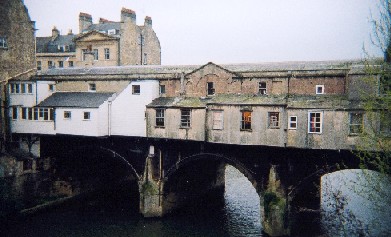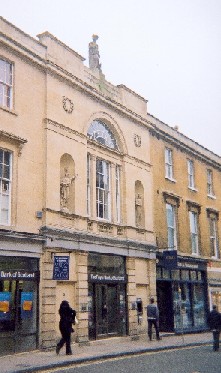|
|
|
| Home | Roman Bath | Dark Ages | Middle Ages | Upheaval | Georgian | Nineteenth century | Twentieth century | Twenty first century |
 Bath in the twenty-first century:
Bath in the twenty-first century:Fable: Welcome to Bath Imperial Health Spa! Bath - Imperial Health Spa. Blessed by generations of monarchs Bath lies in a shining green valley. Steam from the bubbling hot springs rises from the Celebration Baths in the city centre: passers-by are invariably gathered on the stone gallery which surrounds these giant pools to watch the spectacle of healthful exercise which takes place at regular intervals throughout the day......
Right: The Cross Bath before work began. The ducks are deprived of their warm brooding place - when will it reopen as a sanctuary of quiet contemplation?
I am going to rename this the Rant page- it's marginally less vitriolic than the Letters pages in the Bath Chronicle....maybe....See below. Archsweet.
Introduced in late 2000, residents parking permits are now required for people living in some streets (for example Lower Oldfield Park area) - in order to park their car in the street. Note - this does not guarantee them a place to park, and if they can't find a space, they can't park anywhere else - e.g. for free in the main car parks, or in a neighbouring parking permit street.
These permits are rather expensive, and you can only have 2 per house - which means a family with grown up children living at home might end up 2 permits short of legality.
Also - what about those who in the past would drive into Bath from one of these villages whose public transport is, how shall I say, non-existent, and park in the street close to the city centre? The streets would be empty of parked cars because the residents have driven to work in Chippenham or wherever. Then the workers leave and the residents return - all quite neat. No more. Workers who need to drive to Bath now have to use the Park and Ride - which shuts too early for shift workers to find it useful, or those who might attend evening classes, and so on and so on.
So - what use is the permit scheme?
Does it prevent people using cars (i.e.
ease pollution?)
No. If you're coming in to Bath for work from a rural area, or if you need
to drive out of Bath to work, you don't have any choice. You have to drive.
Unless you want to get a taxi everywhere -which still uses a car
Does it makes the streets safer?
No. If you own a car, you have to pay to park it on the street, that's
all. Doesn't affect the way you drive it or how often you drive it.
Does it raise money to provide a more complete public transport system?
No. We don't have a public transport system, remember? The
service providers - Badgerline and so on - are private companies, just
like the taxis.
Does it ease congestion in the city - after all, Bath was not built for motor
vehicles?
No. We're talking about residential areas, not main through routes.
You never could park legally on Queen Square or London Road - it's just that now
you need a permit to park on the previously non-congested streets. If
anything, this has increased the number of vehicles trawling the suburbs, looking
for somewhere to park.
So what does it do then?
It raises money for the Bath and North East Somerset council. This is
in addition to the council tax money already paid by residents, which has risen
hugely 2 years on the trot. In a master-stroke by BANES, those who
have not got off-road parking now have to pay extra to own a car in Bath.
And those who drive into Bath have to pay - guess who? Yes, BANES again - car
parking charges, or Park and Ride charges. It's amazing. Wish I'd
thought of it.
You may guess I am slightly unhappy with the way this scheme has been put in place. But looking at the questions above, it's clear that the only people who benefit from this scheme in any way are BANES. The environment, local residents, city business etc gain nothing from this scheme.
What do you think? Tell me.
Bus gates. These are pop-up devices which sink into the road to allow buses and other designated vehicles to pass, but which rise up and prevent cars from entering the bus-gated area.
In Bath, the gated area will be most of the city centre. Among the designated vehicles will be: emergency services (can't quibble there) buses (private companies), tour buses (private companies) and taxis (private companies) See a pattern emerging? I have a particular problem with the tour buses, who do not even pretend to offer a service to local residents,indeed, in some cases actively reduce their quality of life with noise, fumes and congestion.
Cambridge has had bus-gates for many years. The council performed a feasibility study, and the consultants said it would not necessarily benefit the city. The councl then conducted a survey, which discovered the residents were strongly opposed to the scheme. The council then did it anywyay. Sound at all familiar?
These bus gates are struck by non-designated traffic about once every four hours. Yes, struck - cars drive along somewhat vaguely behind a bus or taxi (perhaps they are tourists, unfamiliar with the city?) then before they know what has happened, a metal pillar has risen up and wrecked the underside of their car. In some cases people have been injured, including one chap who suffered a heart attack at the shock of his airbag inflating on impact with the gate. The council spends a fortune on repairing the gates, and fending off lawsuits from drivers.
Marvellous. And what good do
bus-gates do?
Do they ease congestion?
Maybe. After all, look at Oxford Street, London - only buses and taxis
are permitted and that's a beautiful example of an uncongested street, right?
Do they ease pollution?
Maybe. Those tour buses in particular can be so old they are exempt
from the emissions checks obligatory for most private cars, so we'll never know.
Is it more eco-friendly to promote bus travel?
Yes. Promoting bus travel wins smiles from everyone - even when those
buses contain a solitary passenger, belch revolting fumes, make money for a
private company, and do not offer a public service.
What do you think? Tell
me.
Top

Another scheme which has seen some press is that for a new town just outside Bath, in its green belt. Yes, deliberately constructing a new urban area in a green belt. The justification is that this will be a car free environmentally friendly urban village which relies totally on green forms of transport (buses, trams, etc) and will therefore be adding, somehow, to the richness of the countryside.
Hmmn. I'd like to know where these trams and buses are going to come from. Try going to Box from Bath, in time for work in the morning, without using a car. Go on. Let me know how you do. (see main page for my contact link)
There are plans afoot to build new swimming baths - taking advantage of the hot spring water piping up into the centre of Bath.
 The old baths in Beau Street have been demolished, leaving a massive hole which - seen through the chain link on the street - looks disappointing in terms of archaeological finds. The only thing I can see is a council rubbish bin. The hole has been there about a year now - no sign of work starting on the baths. But when it does:
The old baths in Beau Street have been demolished, leaving a massive hole which - seen through the chain link on the street - looks disappointing in terms of archaeological finds. The only thing I can see is a council rubbish bin. The hole has been there about a year now - no sign of work starting on the baths. But when it does:
The site is contentious to say the least - at the very heart of Bath, close to the source of the Sacred Spring, yards from the Abbey, surrounded by Georgian and Victorian buildings, some of which were themselves reconstructed on medieval sites (Bellotts Hospital and the Abbey Church House).
The new Baths Complex (by Nicholas Grimshaw and partners, the people who gave us Waterloo International terminal) will be a glass cube, - the city just visible through its steamed walls. Bathers could be charged a fee of something like £10.00 - residents may have cheaper access if they donate a few hundred pounds to the building of the complex. Bargain.
For up to date information on the redevelopment of the Beau Street Baths, check the official site: Bath Spa Project
Top
There's a feeling in some archaeological circles that we are very much in danger of choking to death our loveliest towns through over-protection. Bath - a World Heritage Site - has a wealth of well-preserved buildings which deserve to be seen. But is it not false behaviour to a living city, to prevent any future development? Let's face it, we only have Georgian Bath because someone said, let's knock down these crummy Tudor buildings and do something really modern. And the Victorians brought many improvements - their buildings are on the tourist list too now: Guildhall, Concert Room (next to the Pump room), the whole Roman baths building in Stall Street.
So where's the line? How do we decide which new developments will be a long term addition to the city (perhaps the new Beau Street Baths? perhaps the recent retirement complex by Raby Place, or the Podium shopping centre?) and which will mean only the loss of historic buildings for short term commercial gain and some nasty architecture to boot (think Southgate, the Hilton, the area around Charles Street which was destroyed in the war).
Any thoughts? Let me know.
To take the idea still further, and demonstrate the use of technology in preservation of historic towns - why not enclose Bath altogether? A lightweight fabric structure stretched like a giant awning over the entire central city - maybe even attached to Bath's surrounding hills - could protect from pollution, light ageing, and of course the British weather. A soft ambient light would filter through during the day, and at night, lit up from within, Bath would glow like a...well, giant mushroom in its valley.
The technology could be used to protect other key archaeological sites - Stonehenge, the Parthenon, various Roman stadia. The Awning, as it may become known, could be an additional attraction for those coming to Bath - abseiling from its support masts for maintenance could provide part-time income for athletic visitors, and the lack of rain would make the parks ideal for temperature-controlled picnics. Why not?
page last updated on 22 February, 2001
FabledCity by
| Home | Roman Bath | Dark Ages | Middle Ages | Upheaval | Georgian | Nineteenth century | Twentieth century | Twenty first century |